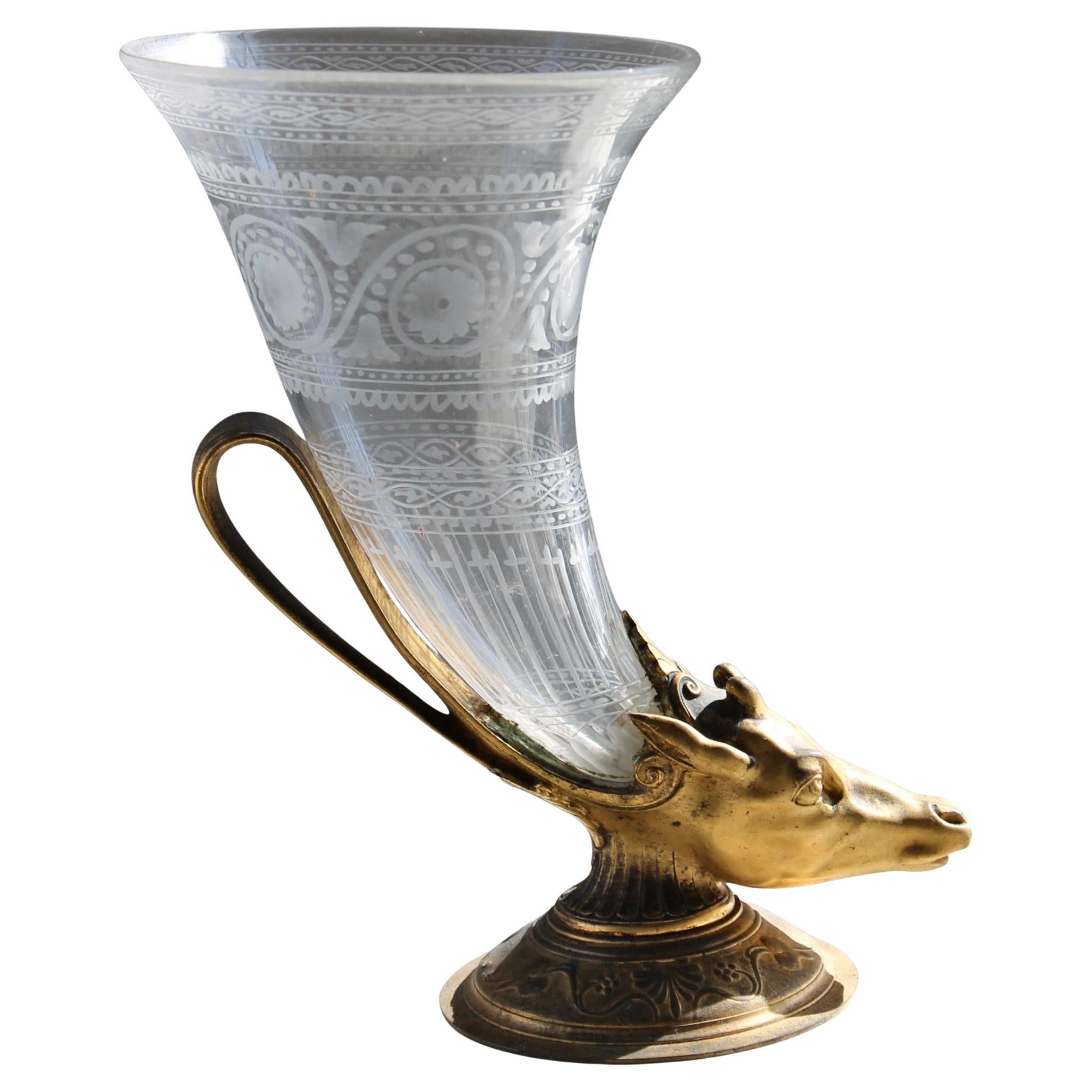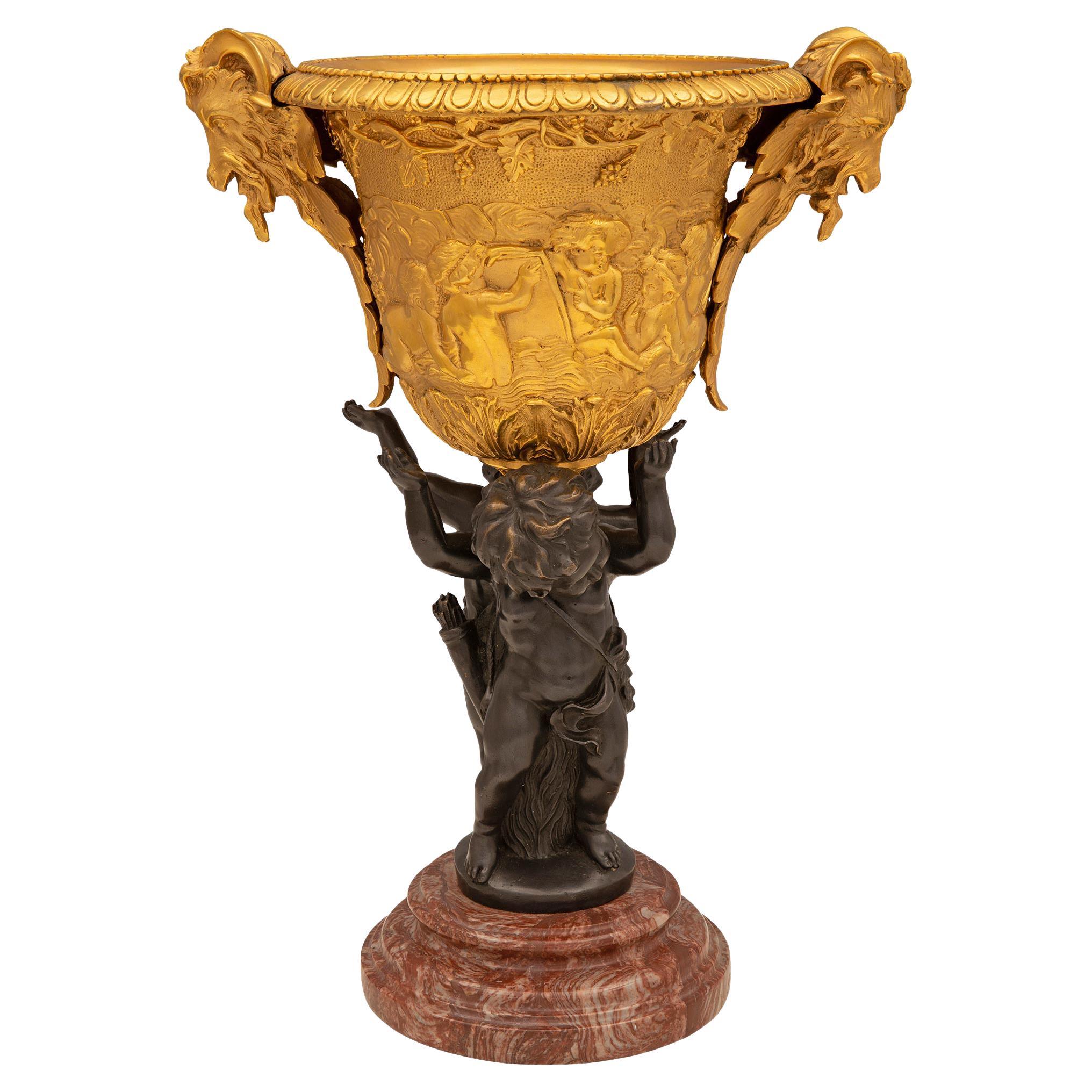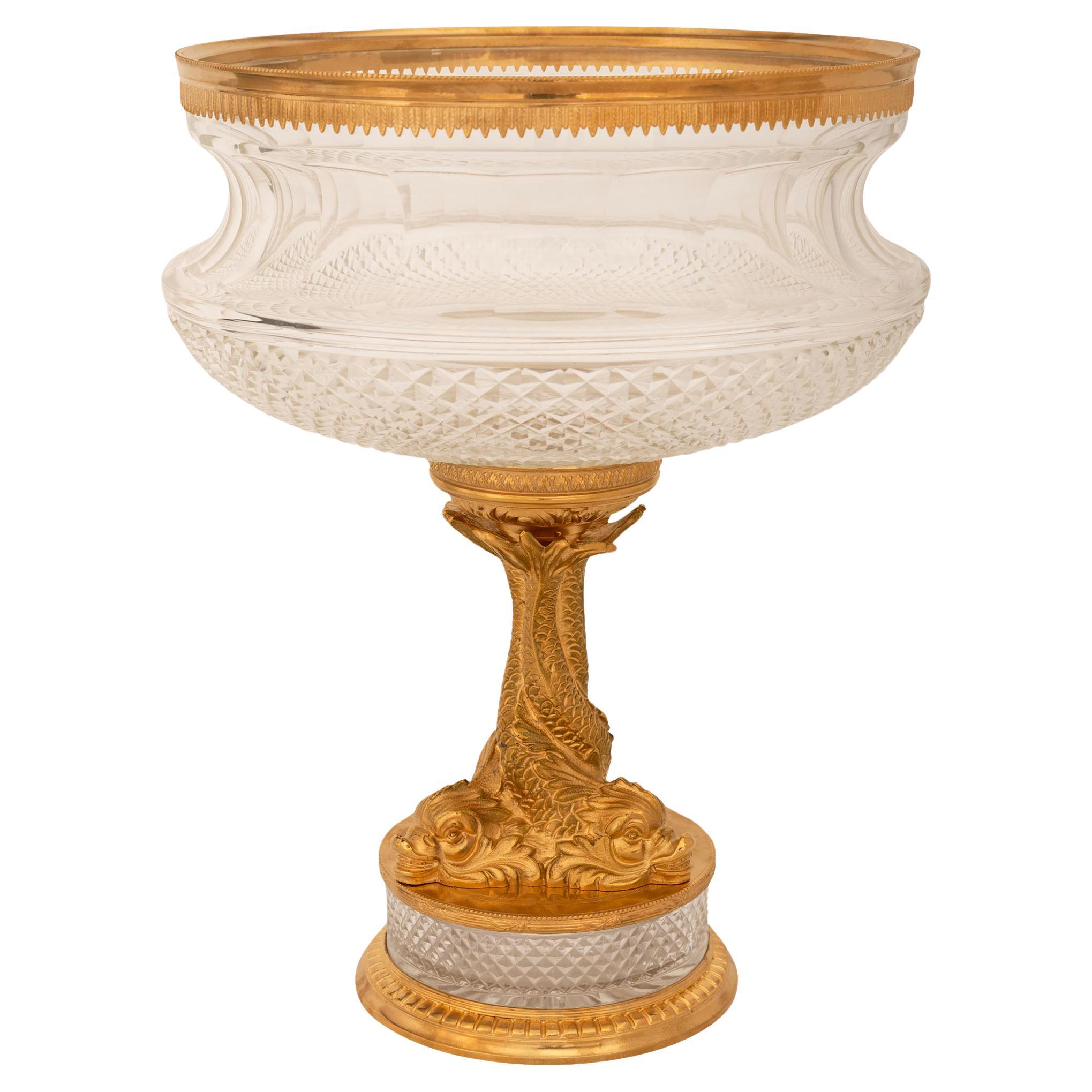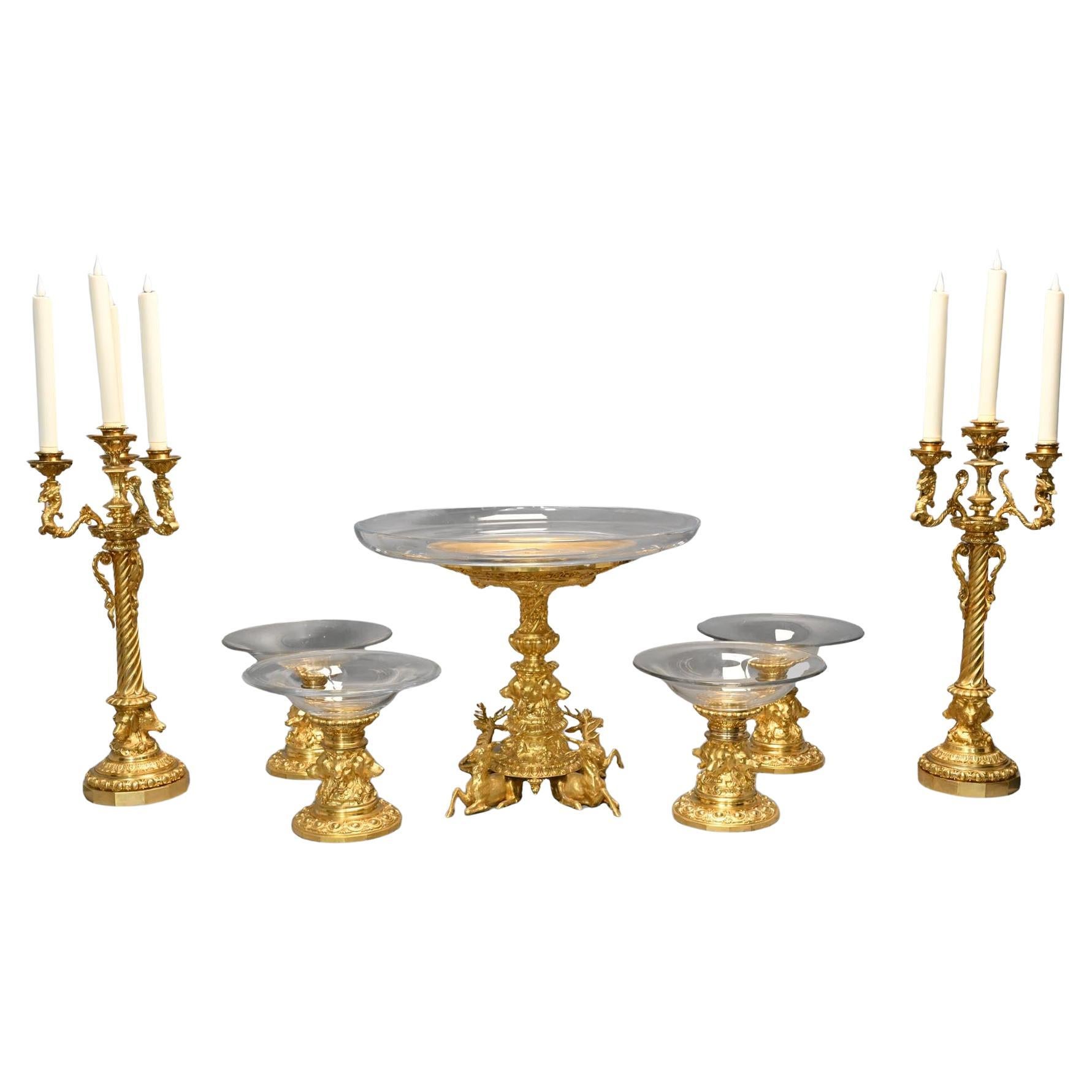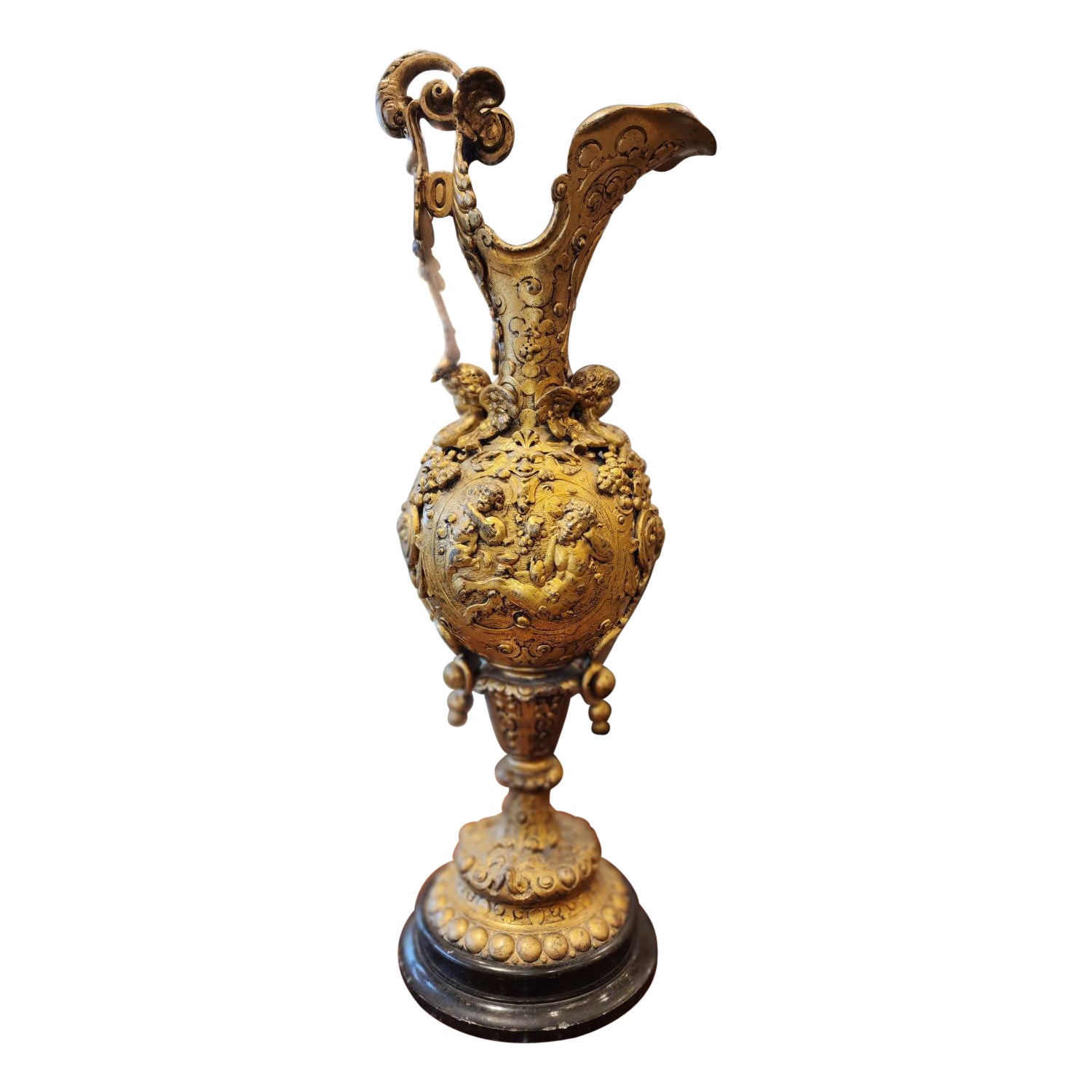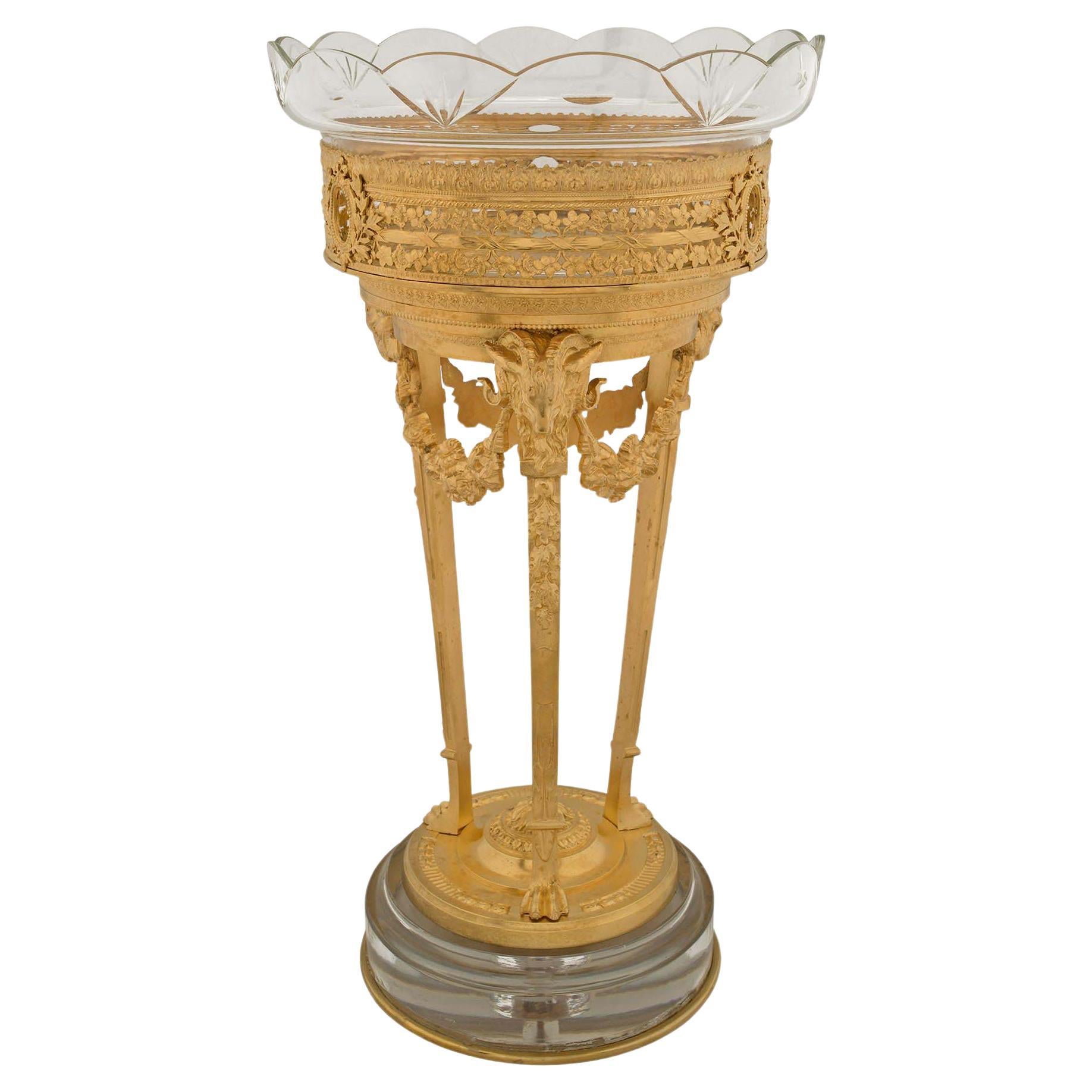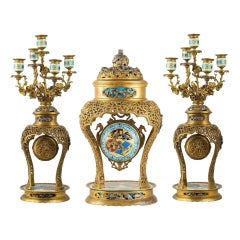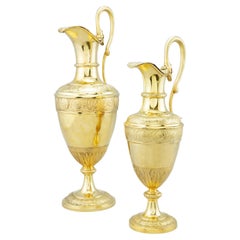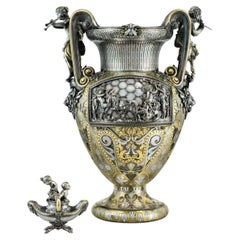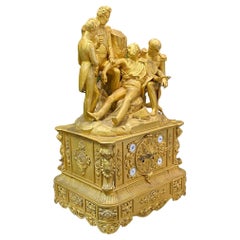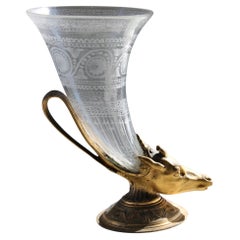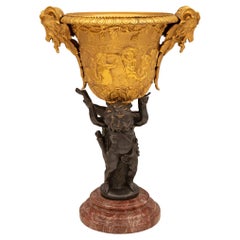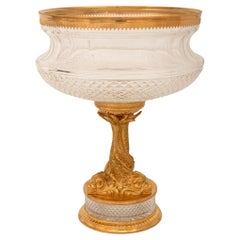Items Similar to French Deer Hunting Trophy by Jean-Francois Deniere Circa 1836
Want more images or videos?
Request additional images or videos from the seller
1 of 19
French Deer Hunting Trophy by Jean-Francois Deniere Circa 1836
$18,000
£13,665.29
€15,630.18
CA$25,148.61
A$27,970.74
CHF 14,605.45
MX$340,374.20
NOK 186,533.93
SEK 174,935.92
DKK 116,654.02
Shipping
Retrieving quote...The 1stDibs Promise:
Authenticity Guarantee,
Money-Back Guarantee,
24-Hour Cancellation
About the Item
Our amazing silver-gilt and gilt-metal hunting cup with its original presentation case was designed by Jean-Francois Deniere for Baron Johan-George Schickler to celebrate his downing of a ten-point stag near Paris in November of eighteen thirty-five.
It has an oval gadrooned base cast with gothic style foliage and applied in the front with a rococo cartouche and coat-of-arms and two shields with initials GS for Baron Johan-Georg Schickler. The stem is formed as a stag's hoof topped by an oak leaf crown above a band of gothic scrolls framing cartouches engraved with inscription, the base fitted with a silver plaque engraved with inscription, with detachable cut-glass cup and original fitted leather case, engraved on base DENIERE A PARIS.
The inscription around the crown reads HALLALI, CARYAN, Porté bas près de Sèvres and attaqué le 6 Novembre 1835 près de Bonnelles. This translates to: KILL, CARYAN carried low near Sèvres and attacked on November 6, 1835 near Bonnelles. The prey celebrated by this trophy apparently named Caryan with the word Hallali translated to the noun, kill.
The inscription on the silvered plaque translates to: This passage translates to: Deer hoof, ten horns, caught by Aubry dit La Branche, first Piqueur of the Mons crew. Baron SCHICKLER, November 6, 1835 at a quarter past twelve in the Bois du Chaillot, near Bonnelles, attacked by 32 dogs and door low, from pack to death without relay at 5 a.m. at Chavilles, near Sèvres, in the yard of a launderer by 20 of the attack dogs, whose names follow. Blucker, Belford, Barbareau, Claireau, Charboneau, Concordan, Flambeau, Fortuneau, Phanor, Forester, Fleuribeau, Gravador, Matador, Mirador, Munireau, Musicau, Marmiteau, Ramponeau, Rafineau, Thibeau. The stag crossed the Parc de Limours, Forges, Janvrys, the woods of Charmeaux, the pond of Marcoussy, Orsay, Palaiseau, the woods of Verrières and those of Meudon and he made five outlets.
Johan Georg Schickler was born in Bordeaux in a wealthy Prussian banking family who emigrated to Switzerland in the 16th century, first in Basel before moving to Mulhouse, Berlin and finally Paris. The family moved in the highest Parisian social circles acquiring the famous hôtel Crozat on the Place Vendôme in 1828 which they filled with works of arts and painting especially equestrian by Carle and Horace Vernet, Géricault, and Eugène Delacroix as the family had a passion for horse racing and hunting. Denière was a bronze maker retailing furnishings, chandeliers, clocks, candelabra, torchères and ornamental mantel clocks, established in 1804 by Jean-Francois Deninger (called Denière) and François Thomas Matelin.
Jean-François Dénière established his business as a fabricant de bronzes in 1803. He was at 58 rue de Turenne in 1813 and by 1820 at 9 rue d'Orléans au Marais. He went into partnership with his son Guillaume in 1844. According to the notes on makers in the French version of the catalogue for the 1862 International Exhibition in London, they were one of the first serious competitors to Thomire. The company's work was illustrated by J.B. Waring in his treatises on both the 1851 and the 1862 exhibitions, and George Wallis of the South Kensington Museum wrote in his analysis of the bronzes and works of art for the Art Journal Supplement 1851 that decorative adjuncts in bronze ormolu formed a very striking feature of Deniere's display. The firm exhibited widely to the end of the century and finally closed in 1903 some sixty years after Thomire. Denière supplied the French and European courts such as Versailles, the Grand Trianon, Buckingham Palace, the Hermitage and the White House. Princes and kings figured among Denierè’s wealthy clients and Denière supplied important commissions to the Mobilier de la Couronne (mainly clocks for the Tuilleries), to Kisselef, the Russian Ambassador, and to Said Pasha, the viceroy of Egypt.
- Dimensions:Height: 11 in (27.94 cm)Width: 8.5 in (21.59 cm)Depth: 3.5 in (8.89 cm)
- Style:Louis Philippe (Of the Period)
- Materials and Techniques:
- Place of Origin:
- Period:
- Date of Manufacture:1836
- Condition:Wear consistent with age and use. Mounting screws for silver plaque missing.
- Seller Location:New York, US
- Reference Number:Seller: 1161stDibs: LU6079227188662
About the Seller
No Reviews Yet
Vetted Professional Seller
Every seller passes strict standards for authenticity and reliability
Established in 1990
1stDibs seller since 2021
- ShippingRetrieving quote...Shipping from: New York, US
- Return Policy
Authenticity Guarantee
In the unlikely event there’s an issue with an item’s authenticity, contact us within 1 year for a full refund. DetailsMoney-Back Guarantee
If your item is not as described, is damaged in transit, or does not arrive, contact us within 7 days for a full refund. Details24-Hour Cancellation
You have a 24-hour grace period in which to reconsider your purchase, with no questions asked.Vetted Professional Sellers
Our world-class sellers must adhere to strict standards for service and quality, maintaining the integrity of our listings.Price-Match Guarantee
If you find that a seller listed the same item for a lower price elsewhere, we’ll match it.Trusted Global Delivery
Our best-in-class carrier network provides specialized shipping options worldwide, including custom delivery.More From This Seller
View AllFrench Japonisme Mantel Clock and Candelabra Attributed to Edouard Lievre
By Edouard Lievre
Located in New York, US
Our mantel clock and candelabra with silvered, gilt and cloisonne enamel surfaces in the French Japonisme style dates from the 1870s and is in good condition. Attributed to the influ...
Category
Antique Late 19th Century French Japonisme Mantel Clocks
Materials
Bronze, Enamel
Matched Pair Antique Austrian Silver-Gilt Ewers Circa 1780s
Located in New York, US
Our pair of elegant silver-gilt ewers are attributed to the Austrian maker, Johann Georg Hann of Vienna, circa 1780-1800. Heights: 17 7/8 and 22 1/2 in; 45 a...
Category
Antique Late 18th Century Austrian Neoclassical Pitchers
Materials
Silver
Boucheron Parcel Gilt Silver Vase and Oil Lamp circa 1880
By Fréderic Boucheron
Located in New York, US
Our important parcel-gilt and patinated silver and glass-mounted vase and matching oil lamp were designed by Paul Legrand (1840-1910) and crafted by the silversmith, Charles Glachant, for Boucheron of Paris, circa 1878-1880. 21 in tall and 16.5 in wide (53.4 by 41.9 cm). 28.56 lbs, 457 oz, 14,210 g.
Provenance: presented to or purchased by Jean-Baptiste Pezon (1827-1897); acquired by a European private collector, perhaps on the death of Jean-Baptiste Pezon in 1897, by descent; acquired by YM Antiques, 2017.
This double walled vase has an amphora form, with body and foot with silver, gilt and patinated and stylized flowers, anthemions and sprays of cherries against an etched and matted ground pierced to reveal a gilt inner wall. The upper body is detachable via a slip-lock, and mounted on both sides with arched panels formed of hexagonal beveled glass tiles. One glass panel applied with bacchic infants taunting a rearing goat and the other side with infants feeding grapes to a lioness under a looming bust of a satyr. The patinated and gilt upswung loop bifurcated handles are mounted with fully modeled figures of Pan bearing a syrinx and thyrsus and a draped maenad playing two flutes, both above roaring lion heads, the rim inset with a slip-lock detachable gilt bowl etched with masks of various representations of Bacchus spaced by ribbons and trophies and with scrolling fruiting vines. The base of interior with detachable base metal drip pan to accommodate the removable oil lamp designed to illuminate the glass tiles from within. The lamp is raised on four hoof feet, the upturned ends cast underneath with masks and with detachable cover mounted with two infant satyrs and flanked by gilt loop handles.
The bacchic themed design featuring cartouches depicting infants taunting a goat and lion, plus prominent lion masks at the handles, certainly appealed to Boucheron's customer, Jean-Baptiste Pezon (1827-1897), who is believed to have commissioned the piece. Pezon was the celebrated lion tamer and headliner of the Grande Menagerie whose profession brought him great fame and fortune in Paris. Born a shepherd boy in Lozere, he is said to have left his home at the age of seventeen in the company of a wolf he had captured and trained years earlier. He headed to Paris and by the age of twenty-one purchased his first lion who he named Brutus. The animal is said to have inspired the Lion of Belfort, the monumental red standstone sculpture by Frederic Bartholdi erected in Belfort in 1880. Toulouse-Lautrec was among his admirers and friends, visiting Pezon's Great Lozerian Menagerie to sketch animals. A large bronze sculpture of Pezon atop a female lion adorns the Pezon family tomb in the Pere Lachaise Cemetery in Paris, as seen in our image here.
The vase and detachable bowl are marked on the underside with the silversmith's mark of Charles Glachant. The underside and upper rim of the lower body is engraved "Fic Boucheron Paris". The lamp is marked on underside and flange of cover for Glachant.
Boucheron archives indicate the vase was inspired by the amphora vases created by the Greek potter, Nikosthenes, 550-510 BC. The Nikosthenic amphora vases are a form of Attic vase recognized for their angular amphora form with broad flat handles. Potted of bright orange-red clay, they were decorated with plant and animal motifs within distinct friezes, with the most significant defining feature being the black figure painting, often highlighted with white accents. In this vase Legrand re-imagines the striking contrast of the black figures against a warm ground through the use of patina and gilding. His inventive use of piercing and double-wall construction create additional levels of texture and depth throughout the body. The same combination of ornamentation was employed in a ewer designed by Legrand in 1880 in the Islamic taste. (See lot 77 of Christie's sale in New York on October 22, 2009.)
Edmé Bouchardon (1698-1762), royal sculptor to Louis XV, may have provided Legrand with inspiration for the vase's iconography. The panel featuring bacchic infants taunting a rearing goat is very similar to a bas relief representation of Winter designed by Bouchardon for the Fontaine des Quarte-Saisons on rue de Grenelle, Paris. Bouchardon debuted his plaster model for the bas relief in 1741, and the fountain was completed in 1745.
The Boucheron firm, founded by the celebrated jeweler, Frédéric Boucheron...
Category
Antique 1880s French Greek Revival Vases
Materials
Silver
Historical King Louis Philippe Ormolu Bronze Mantel Clock, Circa 1838
Located in New York, US
Our French ormolu bronze mantel clock, circa 1838, is entitled "Le Roi Louis Philippe saigne sa propre main & rappelle à la vie le courrier de cabinet Werner tombé de cheval sous les...
Category
Antique Mid-19th Century French Louis Philippe Mantel Clocks
Materials
Bronze
German Rock Crystal and Gilt Brass Coupe with Cover
Located in New York, US
Our extraordinary German cup and cover in the Baroque style, circa 1880s, is crafted from gilt brass and features extensive use of rock crystal, including cabochon and faceted circular jewels. Apparently unsigned. Provenance: Koopman Rare Art, London.
Regilded and in excellent condition. There is a soldered repair to the female's spear.
Founded in London in 1952, Koopman Rare Art is one of the world’s most admired dealers specializing in antique silver, gold and objects de vertu.
Category
Antique Late 19th Century German Baroque Revival Vases
Materials
Quartz, Brass
Antique Chinese Rock Crystal Gilt Metal and Enamel Candelabrum
Located in New York, US
Our extraordinary Chinese candelabrum dates from as early as the 18th century with later 19th century additions is exquisitely crafted from rock crystal and gilt metal with enamel de...
Category
Antique 18th Century Chinese Candelabras
Materials
Quartz, Metal, Enamel
You May Also Like
Etched Glass and Gilt Bronze Rhyton
Located in Sharon, CT
Gold gilt bronze holding a fine etched cornucopia shaped glass.
Category
Antique Early 19th Century French Empire Crystal Serveware
Materials
Bronze
French 19th Century Louis XVI St. Bronze, Ormolu, and Marble Centerpiece
Located in West Palm Beach, FL
A remarkable and most charming French 19th century Louis XVI st. ormolu, patinated bronze, and Rose Vif des Pyrénées marble centerpiece. The centerpiece is raised by an elegant circu...
Category
Antique 19th Century French Louis XVI Centerpieces
Materials
Marble, Bronze, Ormolu
French 19th century Louis XVI st. Ormolu and Glass centerpiece
Located in West Palm Beach, FL
An elegant and high quality French 19th century Louis XVI st. Ormolu and Glass centerpiece. This attention grabbing centerpiece is raised by a lattice cut circular Glass pedestal sup...
Category
Antique 19th Century French Louis XVI Centerpieces
Materials
Ormolu
THOMIRE & Cie, Hunting-Themed Centerpiece
By Thomire & Cie.
Located in SAINT-OUEN-SUR-SEINE, FR
This hunting-themed centerpiece was crafted by the Thomire & Cie company around 1850.
Pierre-Philippe Thomire (1751-1843) was the most famous member of a distinguished family of ar...
Category
Antique Mid-19th Century French Renaissance Revival Centerpieces
Materials
Bronze
$64,699 / set
Antique Napoleon III Period Bronze
Located in Dallas, TX
One of a kind Antique Napoleon III Period Bronze ewer. Kept in sparkling condition. Perfect for hallway Decor.
Category
Antique 18th Century French Napoleon III Centerpieces
Materials
Bronze
$3,600 Sale Price
20% Off
French 19th Century Louis XVI St. Ormolu and Baccarat Crystal Présentoire
Located in West Palm Beach, FL
A very decorative French 19th century Louis XVI st. ormolu and Baccarat crystal Présentoire. The centerpiece is raised by a solid Baccarat crystal base...
Category
Antique 19th Century French Louis XVI Centerpieces
Materials
Crystal, Ormolu
